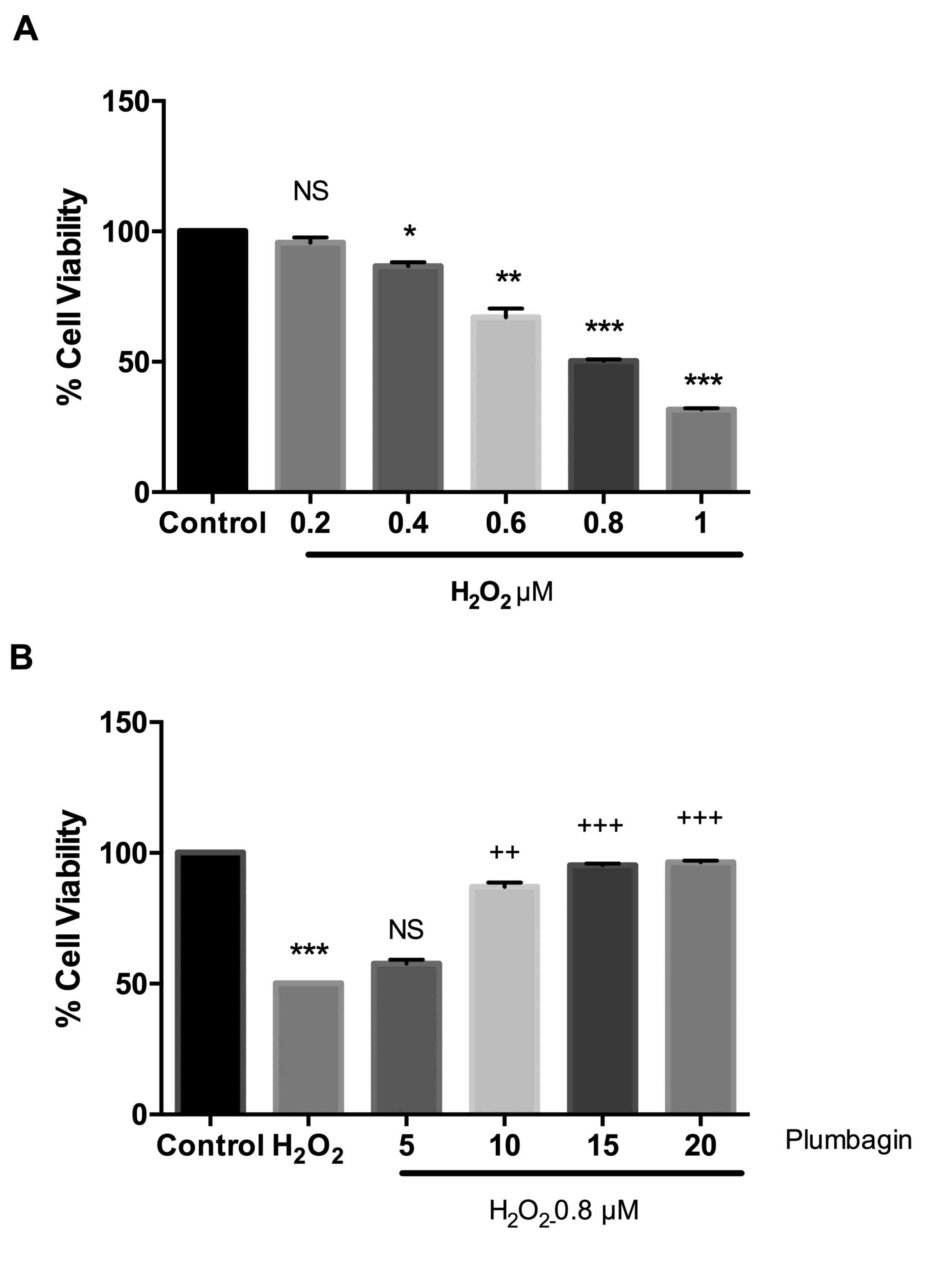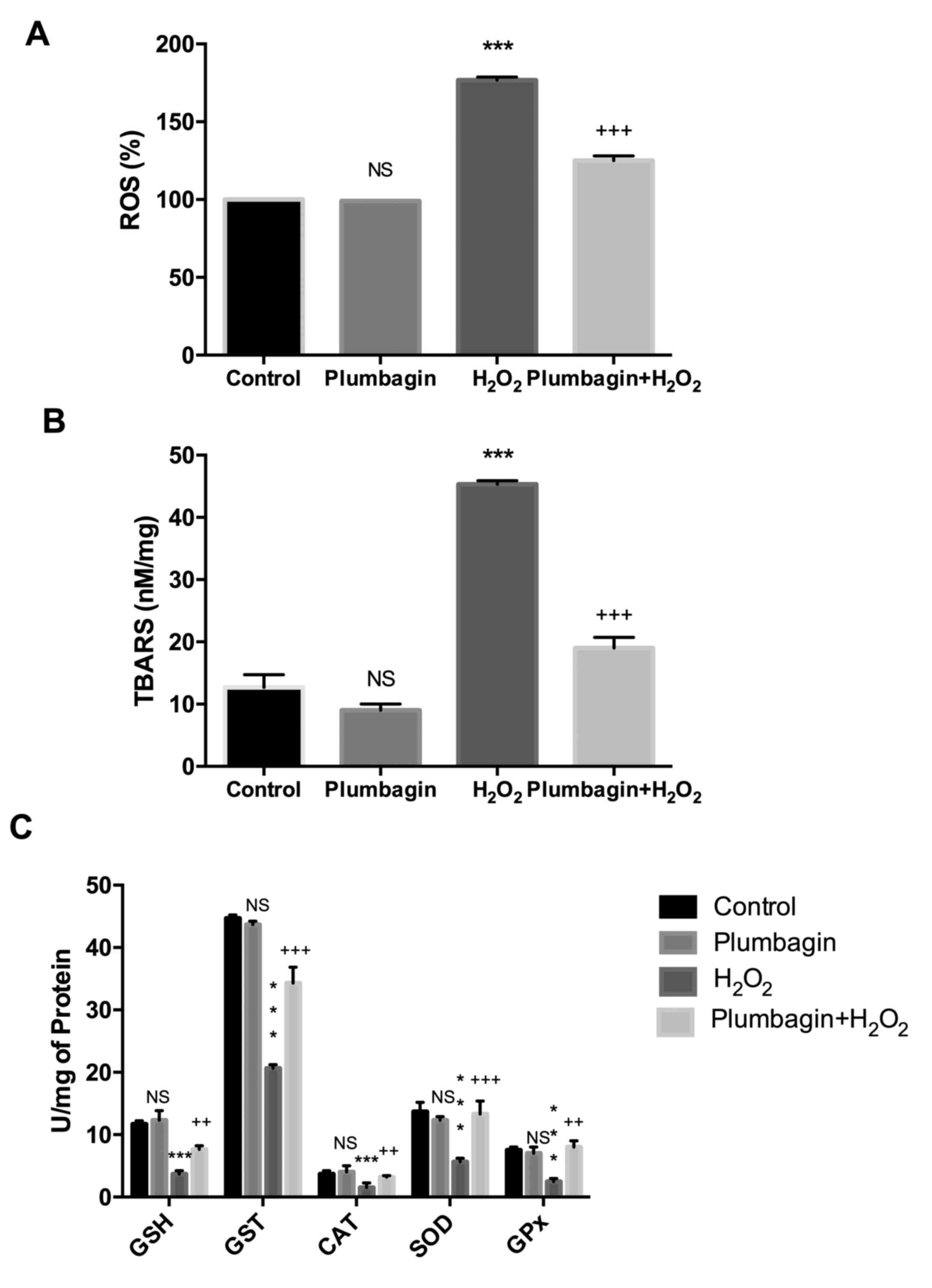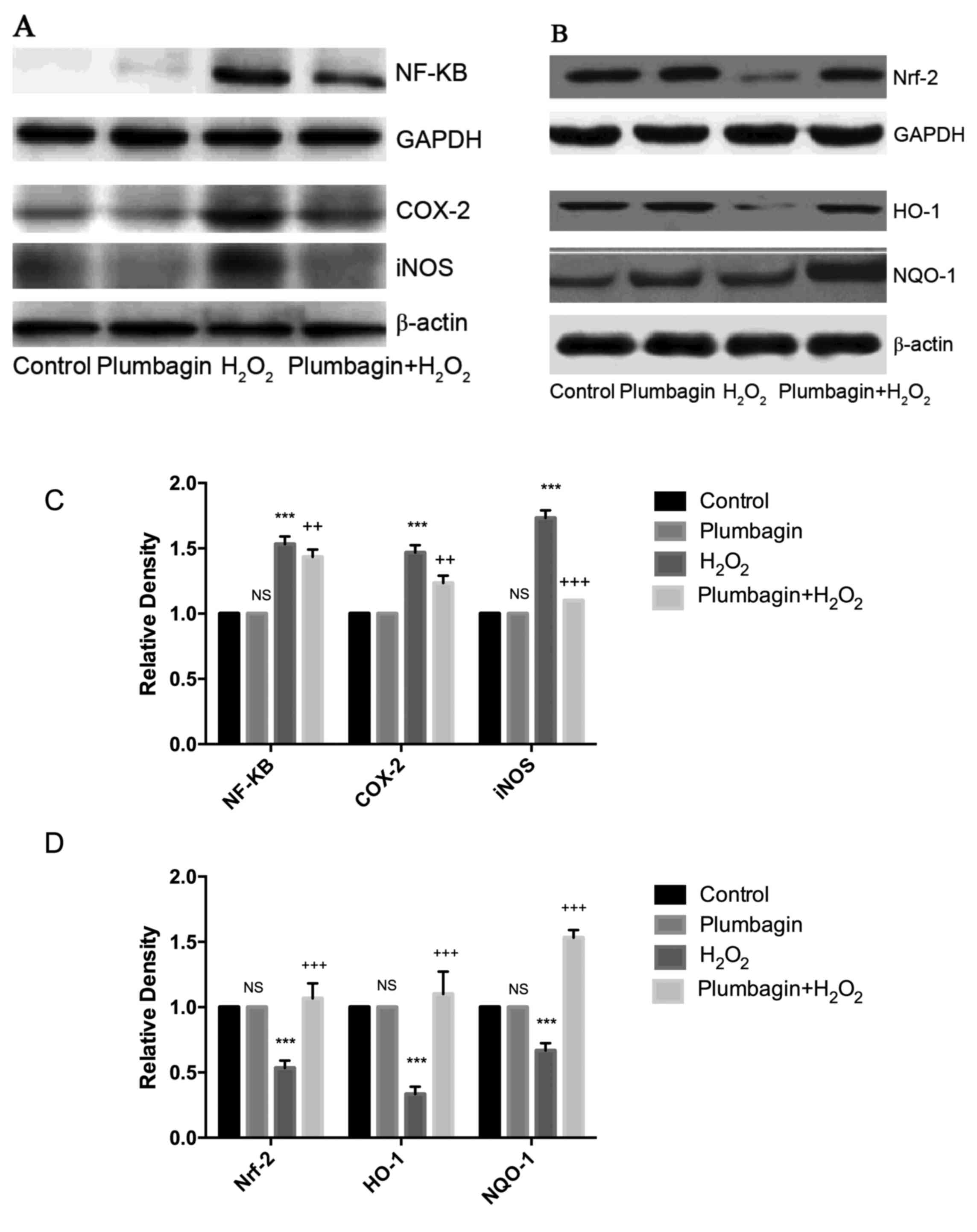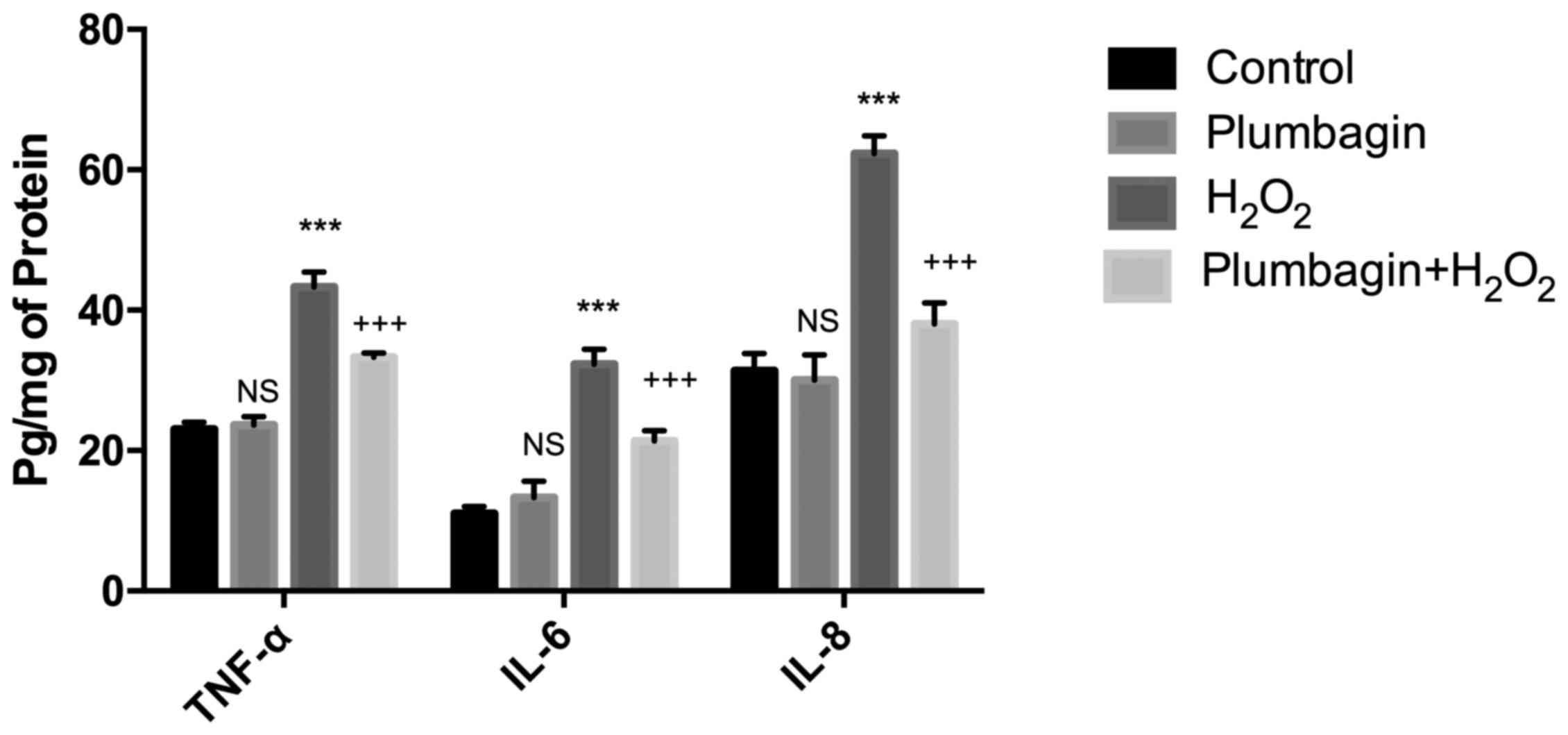Plumbagin prevents osteoarthritis in human chondrocytes through Nrf-2 activation
- Authors:
- Published online on: February 22, 2017 https://doi.org/10.3892/mmr.2017.6234
- Pages: 2333-2338
Abstract
Introduction
Osteoarthritis (OA) is a chronic inflammatory disorder, its incidence increasing with obesity, poor lifestyle and ageing. Hydrogen peroxide (H2O2)-induced oxidative stress and loss of inflammatory homeostasis causes cartilage degeneration leading to OA and H2O2 is released during acute inflammatory responses (1,2). Oxidative damage and activation of cellular redox signaling mechanisms by H2O2 in chondrocytes is associated with the pathogenesis of OA (3). H2O2-induced oxidative stress causes proteoglycan degradation with structural and functional changes ultimately leading to apoptosis (2,4). Since oxidative stress serves a critical role in the development of OA, an effective preventative strategy may be stimulated through antioxidants and thereby redress redox imbalance.
Plumbagin (5-hydroxy-2-methyl-1, 4-aphthoquinone; C11H8O3) occurs in various plant families including plumbaginaceae, Droseraceae and Ebenceae. It exhibits antioxidant properties and is involved in various biological activities against bacterial and fungal infection, inflammation and various types of cancer (5–9). The effect of plumbagin against osteosarcoma has been previously demonstrated through reactive oxygen species (ROS)-mediated activation of pro-apoptosis (10). Increasing evidence suggests that plumbagin also prevents migration of gastric and breast cancer by suppressing the chemokine receptor type 4 (11). Plumbagin acts as anti-inflammatory compound that suppresses lipopolysaccharide-induced endotoxemia by regulating nuclear factor-κB (NF-κB) and carrageenan-induced rat paw edema by modulating inflammatory mediators (12,13).
The present study evaluated the potential role of plumbagin against H2O2-induced oxidative stress and inflammation in primary culture of rat chondrocytes. The study evaluated various oxidative stress parameters, including ROS levels, antioxidant status and redox regulation of nuclear factor (erythroid-derived 2)-like 2 (Nrf-2), NF-κB and inflammatory cytokine levels. Therefore, plumbagin may be able to provide protection against osteoarthritis by modulating oxidative stress and inflammatory pathways.
Materials and methods
Reagents
Dulbecco's modified Eagle's medium (DMEM), fetal calf serum, antibiotics, antimycolytic solution, 3-(4,5-dimethylthiazol-2-yl)-2,5-diphenyltetrazolium bromide (MTT) and 2′,7′-dichlorofluorescin diacetate (DCF-DA) were obtained from Gibco BRL (Gaithersburg, MD, USA). Primary antibodies used at 1:1,000 dilutions [NF-κB (cat.no. 3031), cyclooxygenase-2 (COX-2) (cat. no. 12282), Nrf-2 (cat. no. ab31163), inducible NO synthase (iNOS) (cat. no. ab3523), NAD(P)H:quinone oxidoreductase 1 (cat. no. ab2346), heme oxygenase 1 (HO-1) (cat. no. ab13243)] and secondary antibodies used at 1:10,000 dilutions [(Anti-rabbit IgG, horseradish peroxidase-conjugated (HRP)-linked antibody (cat. no. 7074) and anti-mouse IgG, HRP-conjugated antibody (cat. no. 7076)] were used in the present study were purchased from CST Biological Reagents Co., Ltd., Shanghai, China.
Cell culture and cell viability
Primary rat chondrocytes were used in the present study. The isolation and cell culture were carried out as described previously (14). Cell viability was assessed by MTT assay. Cells (1×104) were seeded and allowed to attach overnight. Subsequently, cells were treated with different concentrations of H2O2 (0.2–1.0 µM) for 24 h. The half maximal inhibitory concentration (IC50) was identified to be 0.8 µM. In order to determine the protective effect of plumbagin against H2O2-induced oxidative stress, cells were pre-treated with plumbagin and then with 0.8 µM H2O2 for 24 h at 37°C. Cells were treated with MTT for 5 h at 37°C and quantified at 570 nm (15).
Oxidative stress markers Intracellular ROS generationCells were pre-treated with plumbagin and then with DCF-DA for 1 h at 37°C. To identify the protective effect of plumbagin against H2O2-induced oxidative stress, cells were washed and treated with H2O2 for 24 h. Cells were treated with plumbagin and H2O2 alone, and control cells without any treatment were maintained. Following complete treatment, cells were suspended in phosphate buffered saline and ROS levels were measured fluorimetrically (16).
Lipid PeroxidationFollowing treatment, cells were analyzed for lipid peroxidation content using a Lipid Peroxidation (MDA) assay kit (cat. no. ab118970; Abcam, Cambridge, UK) in accordance with the manufacturer's protocol.
Antioxidant enzyme activitiesAntioxidant assay kits were used for determining the specific activities. Superoxide dismutase activity (cat. no. 706002; Cayman Chemical Company, Ann Arbor, MI, USA), catalase (CAT) activity (cat. no. 707002; Cayman Chemical Company), Glutathione-S-Transferase (GST) activity (cat. no. 703302; Cayman Chemical Company), Glutathione Peroxidase (GPx) activity: (cat. no. 703102; Cayman Chemical Compnay) and glutathione (GSH) levels (cat. no. 703002; Cayman chemicals) were assessed.
Pro-inflammatory cytokine expression levelsFollowing treatment with plumbagin and H2O2, cell supernatants were analyzed for tumor necrosis factor-α (TNF-α), interleukin (IL)-1β and IL-6 levels using ELISA kits (Abcam). The levels of interleukins were expressed as pg/mg protein.
Immunoblot analysisCells were lysed using radioimmunoprecipitation assay buffer (cat. no. 89900; Thermo Fisher Scientific, Inc., Waltham, MA, USA) for the isolation of whole cell protein extract. The nuclear extract was isolated using NE-PER Nuclear and Cytoplasmic Extraction Reagents, Thermofisher Scientific, (cat. no. 78833) for the determination of the expression levels of NF-κB and Nrf-2. The samples were run on 12% SDS-PAGE gels, and then transferred onto nitrocellulose membranes. The membranes were incubated with 5% non-fat milk for 2 h. Following washing, the blot was incubated with primary (1:1,000) and secondary antibodies (1:10,000). The bands were developed with enhanced chemiluminescence and the images were analyzed using ImageJ software (https://imagej.nih.gov/ij).
Statistical analysisThe results are expressed as mean ± standard deviation. One-way analysis of variance followed by Tukey's multiple comparison tests was performed for determining significance. SPSS software (version, 16.0; SPSS, Inc., Chicago, IL, USA) was used and statistical significance was set as ***P<0.001, when compared with the control, and ++P<0.01, +++P<0.001, when compared to the H2O2 group.
Results
Cell viability was increased by plumbagin treatmentIn order to test H2O2-induced cell death, an MTT viability assay was performed. H2O2-induced dose-dependent cell viability was compared with that of the control cells. The IC50 value was found to be 0.8 µM. Next, the cells were pre-treated with different concentrations of plumbagin for 24 h and then treated with H2O2. Plumbagin dose-dependently improved the cell viability compared with H2O2-treated cells. However, treatment with plumbagin alone caused no cell death compared with that of the control cells (data not shown). plumbagin at 15 and 20 µM showed a protective effect and 15 µM was selected for further molecular studies, (Fig. 1A and B).
Plumbagin prevents H2O2-induced oxidative stressH2O2 treatment of chondrocytes caused an increase in oxidative markers, including ROS and lipid peroxides, compared with control cells. Pre-treatment with plumbagin reduced these marker levels compared with those of H2O2 treated cells. Plumbagin treatment alone did not affect the oxidative stress marker levels (Fig. 2A and B). In addition, antioxidant enzyme activities including GSH, SOD, GST, GPx and CAT activities, were estimated for different groups. It was identified that H2O2 treatment reduced the antioxidant defense system by significantly reducing the levels compared with those of control cells. However, treatment with plumbagin increased the antioxidant enzyme activities to significant levels compared with those of H2O2-treated cells (Fig. 2C).
Plumbagin modulates NF-κB and Nrf-2 signalingNext the H2O2-induced oxidative stress and inflammation in chondrocytes through NF-κB and Nrf-2 signaling was evaluated. H2O2 treatment induced inflammatory signaling through increased NF-κB expression levels and the downstream targets (COX-2 and iNOS). Furthermore, Nrf-2 levels were significantly downregulated in chondrocytes treated with H2O2 compared with those of control cells. Nrf-2-induced expression levels of HO-1 and NQO-1 were significantly reduced. Plumbagin treatment followed by H2O2 treatment downregulated NF-κB and upregulated Nrf-2 levels (Fig. 3A and B).
Plumbagin reduces inflammatory cytokine expressionPro-inflammatory cytokine expression, including TNF-α, IL-6 and IL-8, were evaluated by ELISA. H2O2 treatment increased the pro-inflammatory cytokine expression compared with that of control cells, while plumbagin pre-treatment significantly downregulated the cytokine expression levels (Fig. 4).
Discussion
The present study demonstrated certain important findings on plumbagin-mediated cytoprotection against OA in chrondrocytes by the regulation of redox signaling and inflammation. H2O2 treatment dose-dependently decreased chondrocyte viability, whereas plumbagin pre-treatment improved the cell viability of chondrocytes by up to 97%. Furthermore, H2O2 caused severe oxidative stress in chondrocytes by increasing the ROS and lipid peroxide levels. Previous studies (17,18) have demonstrated the potential role of H2O2 in inducing oxidative stress with functional loss of chondrocytes and the development of OA. Plumbagin treatment reduced the oxidative stress markers perhaps due to its antioxidant potential. Plumbagin has been previously reported (19,20) as having strong antioxidant properties and thereby associated anti-mutagenic and anti-cancer effects.
The present study analyzed the detailed molecular mechanism of plumbagin's protection against H2O2-induced effects on chondrocytes. It identified that H2O2 treatment increased the oxidative stress by downregulating Nrf-2 signaling. Nrf-2 is the nuclear transcription factor activated under oxidative stress and translocates into the nucleus. Nrf-2 induces expression of antioxidant responsive element (ARE)-responsive genes including, NQO-1, GST, HO-1 at the transcriptional level (21). In the current study, H2O2-induced redox signaling is mediated through increased ROS levels and a decline in the expression levels of Nrf-2 and downstream proteins. This imbalance may be due to exacerbated oxidative stress, which is not sufficiently ameliorated by the endogenous antioxidant defence system inside the cells. However, treatment with plumbagin improved the antioxidant defence mechanism by inducing nuclear Nrf-2, HO-1 and NQO-1 expression levels. HO-1 is activated by oxidative stress and inflammatory cytokines, and produces biliverdin and bilirubin, which exert a cytoprotective effect by ameliorating ROS (22–24). Another important antioxidant enzyme is NQO-1 (also called DT-diaphorase). This serves a major role in preventing oxidative stress by reducing quinones to hydroquinones (25). A previous study by Son et al (26), reported the protective role of plumbagin by activating Nrf-2/ARE signaling against cerebral ischemia.
NF-κB is a redox sensitive transcription factor that is central to inflammation. NF-κB is held in the cytoplasm by inhibitor of κB (IκB) proteins, which thereby regulates its expression levels. Under oxidative stress, IκB undergoes proteosomal degradation resulting in nuclear localization of NF-κB, which induces the expression levels of various inflammatory proteins, including COX-2, iNOS and inflammatory cytokines (27). In the present study, it was identified that H2O2 induces NF-κB activation and expression and further upregulated its downstream genes COX-2 and iNOS. The results of the present study are consistent with previous reports on H2O2-induced NF-κB activation, regulated through phosphorylation of IκB (28,29). H2O2 induces COX-2 expression through tyrosine kinase phosphorylation and is involved in wound repair in human umbilical vein endothelial cells (30). The H2O2-induced NF-κB levels and increased expression levels of inflammatory cytokines observed in the present study are consistent with the previous study of Lim et al (31), where the authors demonstrated the protective role of melatonin against H2O2-induced inflammatory effects on the CHON-001 human chondrocyte cell line and a rabbit OA model. These H2O2-induced inflammatory effects were significantly downregulated by plumbagin preventing NF-κB expression levels and their downstream targets (COX-2, iNOS, TNF-α, IL-18 and IL-6). plumbagin suppressed osteoclastogenesis and osteolytic metastasis by downregulating receptor activator of NF-κB ligand-induced NF-κB activation (32). The immunomodulatory activity of plumbagin has been previously demonstrated by Checker et al (33) by suppressing Concanavalin A-induced NF-κB expression levels and various cytokine (IL-2, IL-4, IL-6 and interferon-γ) levels. Plumbagin also suppresses carrageenan induced edema by downregulating pro-inflammatory cytokines (13). Thus, H2O2-induced inflammation may be regulated by plumbagin modulating the NF-κB transcription factor and thereby regulating its downstream targets.
The findings of the present study are that plumbagin is a cytoprotective compound against H2O2-induced oxidative stress and inflammatory responses in chondrocyte cells. Additionally, plumbagin prevents oxidative stress by regulating Nrf-2 levels, induces the expression of antioxidant genes and improves the overall cellular antioxidant defense mechanism. In addition, plumbagin modulates NF-κB levels and suppresses inflammation by downregulating COX-2, iNOS and inflammatory cytokine expression levels. As a result, the present study provide evidence that plumbagin has the potential to protect against osteoarthritis by regulating redox signaling and inflammation.
References
|
Martin JA and Buckwalter JA: Roles of articular cartilage aging and chondrocyte senescence in the pathogenesis of osteoarthritis. Iowa Orthop J. 21:1–7. 2001.PubMed/NCBI | |
|
Shah R, Raska K Jr and Tiku ML: The presence of molecular markers of in vivo lipid peroxidation in osteoarthritic cartilage: A pathogenic role in osteoarthritis. Arthritis Rheum. 52:2799–2807. 2005. View Article : Google Scholar : PubMed/NCBI | |
|
Maneesh M, Jayalekshmi H, Suma T, Chatterjee S, Chakrabarti A and Singh TA: Evidence for oxidative stress in osteoarthritis. Indian J Clin Biochem. 20:129–130. 2005. View Article : Google Scholar : PubMed/NCBI | |
|
Ziskoven C, Jäger M, Zilkens C, Bloch W, Brixius K and Krauspe R: Oxidative stress in secondary osteoarthritis: From cartilage destruction to clinical presentation? Orthop Rev (Pavia). 2:e232010. View Article : Google Scholar : PubMed/NCBI | |
|
Durga R, Sridhar P and Polasa H: Effects of plumbagin on antibiotic resistance in bacteria. Indian J Med Res. 91:18–20. 1990.PubMed/NCBI | |
|
Dzoyem JP, Tangmou JG, Lontsi D, Etoa FX and Lohoue PJ: In vitro antifungal activity of extract and plumbagin from the stem bark of Diospyros crassiflora hiern (Ebenaceae). Phytotherapy Res. 21:671–674. 2007. View Article : Google Scholar | |
|
Thasni KA, Rakesh S, Rojini G, Ratheeshkumar T, Srinivas G and Priya S: Estrogen-dependent cell signaling and apoptosis in BRCA1-blocked BG1 ovarian cancer cells in response to plumbagin and other chemotherapeutic agents. Ann Oncol. 19:696–705. 2008. View Article : Google Scholar : PubMed/NCBI | |
|
Kuo PL, Hsu YL and Cho CY: Plumbagin induces G2-M arrest and autophagy by inhibiting the AKT/mammalian target of rapamycin pathway in breast cancer cells. Mol Cancer Ther. 5:3209–3221. 2006. View Article : Google Scholar : PubMed/NCBI | |
|
Hsu YL, Cho CY, Kuo PL, Huang YT and Lin CC: Plumbagin (5-Hydroxy-2-methyl-1,4-naphthoquinone) induces apoptosis and cell cycle arrest in A549 cells through p53 accumulation via c-Jun NH2-terminal kinase-mediated phosphorylation at serine 15 in vitro and in vivo. J Pharmacol Exp Ther. 318:484–494. 2006. View Article : Google Scholar : PubMed/NCBI | |
|
Tian LQ, Yin DL, Ren Y, Gong C, Chen AM and Guo FJ: Plumbagin induces apoptosis via the p53 pathway and generation of reactive oxygen species in human osteosarcoma cells. Mol Med Rep. 5:126–132. 2012.PubMed/NCBI | |
|
Manu KA, Shanmugam MK, Rajendran P, Li F, Ramachandran L, Hay HS, Kannaiyan R, Swamy SN, Vali S, Kapoor S, et al: Plumbagin inhibits invasion and migration of breast and gastric cancer cells by downregulating the expression of chemokine receptor CXCR4. Mol Cancer. 10:1072011. View Article : Google Scholar : PubMed/NCBI | |
|
Luo P, Wong YF, Ge L, Zhang ZF, Liu Y, Liu L and Zhou H: Anti-inflammatory and analgesic effect of plumbagin through inhibition of nuclear factor-κB activation. J Pharmacol Exp Ther. 335:735–742. 2010. View Article : Google Scholar : PubMed/NCBI | |
|
Checker R, Patwardhan R, Sharma D, Menon J, Thoh M, Sandur SK, Sainis KB and Poduval TB: Plumbagin, a vitamin K3 Analogue, abrogates lipopolysaccharide-induced oxidative stress, inflammation and endotoxic shock via NF-κB suppression. Inflammation. 37:542–554. 2014. View Article : Google Scholar : PubMed/NCBI | |
|
Jiang L, Li L, Geng C, Gong D, Jiang L, Ishikawa N, Kajima K and Zhong L: Monosodium iodoacetate induces apoptosis via the mitochondrial pathway involving ROS production and caspase activation in rat chondrocytes in vitro. J Orthop Res. 31:364–369. 2013. View Article : Google Scholar : PubMed/NCBI | |
|
Mosmann T: Rapid colorimetric assay for cellular growth and survival: Application to proliferation and cytotoxicity assays. J Immunol Methods. 65:55–63. 1983. View Article : Google Scholar : PubMed/NCBI | |
|
Royall JA and Ischiropoulos H: Evaluation of 2′,7′-dichlorofluorescin and dihydrorhodamine 123 as fluorescent probes for intracellular H2O2 in cultured endothelial cells. Arch Biochem Biophys. 302:348–355. 1993. View Article : Google Scholar : PubMed/NCBI | |
|
Khan IM, Gilbert SJ, Caterson B, Sandell LJ and Archer CW: Oxidative stress induces expression of osteoarthritis markers procollagen IIA and 3B3(−) in adult bovine articular cartilage. Osteoarthritis Cartilage. 16:698–707. 2008. View Article : Google Scholar : PubMed/NCBI | |
|
Yudoh K, Nguyen vT, Nakamura H, Hongo-Masuko K, Kato T and Nishioka K: Potential involvement of oxidative stress in cartilage senescence and development of osteoarthritis: Oxidative stress induces chondrocyte telomere instability and downregulation of chondrocyte function. Arthritis Res Ther. 7:R380–R391. 2005. View Article : Google Scholar : PubMed/NCBI | |
|
Kumar S, Gautam S and Sharma A: Antimutagenic and antioxidant properties of plumbagin and other naphthoquinones. Mutat Res. 755:30–41. 2013. View Article : Google Scholar : PubMed/NCBI | |
|
Tan M, Liu Y, Luo X, Chen Z and Liang H: Antioxidant activities of plumbagin and its Cu (II) complex. Bioinorg Chem Appl. 2011:8987262011. View Article : Google Scholar : PubMed/NCBI | |
|
Nguyen T, Nioi P and Pickett CB: The Nrf2-antioxidant response element signaling pathway and its activation by oxidative stress. J Biol Chem. 284:13291–13295. 2009. View Article : Google Scholar : PubMed/NCBI | |
|
Ryter SW, Alam J and Choi AM: Heme oxygenase-1/carbon monoxide: From basic science to therapeutic applications. Physiological Rev. 86:583–650. 2006. View Article : Google Scholar | |
|
Tenhunen R, Marver HS and Schmid R: The enzymatic conversion of heme to bilirubin by microsomal heme oxygenase. Proc Natl Acad Sci USA. 61:748–755. 1968. View Article : Google Scholar : PubMed/NCBI | |
|
Terry CM, Clikeman JA, Hoidal JR and Callahan KS: Effect of tumor necrosis factor-alpha and interleukin-1 alpha on heme oxygenase-1 expression in human endothelial cells. Am J Physiol. 274:H883–H891. 1998.PubMed/NCBI | |
|
Gutierrez PL: The role of NAD(P)H oxidoreductase (DT-diaphorase) in the bioactivation of quinone-containing antitumor agents: A review. Free Radic Biol Med. 29:263–275. 2000. View Article : Google Scholar : PubMed/NCBI | |
|
Son TG, Camandola S, Arumugam TV, Cutler RG, Telljohann RS, Mughal MR, Moore TA, Luo W, Yu QS, Johnson DA, et al: Plumbagin, a novel Nrf2/ARE activator, protects against cerebral ischemia. J Neurochem. 112:1316–1326. 2010. View Article : Google Scholar : PubMed/NCBI | |
|
Morgan MJ and Liu ZG: Crosstalk of reactive oxygen species and NF-κB signaling. Cell Res. 21:103–115. 2011. View Article : Google Scholar : PubMed/NCBI | |
|
Kutuk O and Basaga H: Aspirin prevents apoptosis and NF-kappaB activation induced by H2O2 in hela cells. Free Radic Res. 37:1267–1276. 2003. View Article : Google Scholar : PubMed/NCBI | |
|
Takada Y, Mukhopadhyay A, Kundu GC, Mahabeleshwar GH, Singh S and Aggarwal BB: Hydrogen peroxide activates NF-kappa B through tyrosine phosphorylation of I kappa B alpha and serine phosphorylation of p65: Evidence for the involvement of I kappa B alpha kinase and Syk protein-tyrosine kinase. J Biol Chem. 278:24233–24241. 2003. View Article : Google Scholar : PubMed/NCBI | |
|
Eligini S, Arenaz I, Barbieri SS, Faleri ML, Crisci M, Tremoli E and Colli S: Cyclooxygenase-2 mediates hydrogen peroxide-induced wound repair in human endothelial cells. Free Radic Biol Med. 46:1428–1436. 2009. View Article : Google Scholar : PubMed/NCBI | |
|
Lim HD, Kim YS, Ko SH, Yoon IJ, Cho SG, Chun YH, Choi BJ and Kim EC: Cytoprotective and anti-inflammatory effects of melatonin in hydrogen peroxide-stimulated CHON-001 human chondrocyte cell line and rabbit model of osteoarthritis via the SIRT1 pathway. J Pineal Res. 53:225–237. 2012. View Article : Google Scholar : PubMed/NCBI | |
|
Sung B, Oyajobi B and Aggarwal BB: Plumbagin Inhibits osteoclastogenesis and reduces human breast cancer-induced osteolytic bone metastasis in mice through suppression of RANKL signaling. Mol Cancer Ther. 11:350–359. 2012. View Article : Google Scholar : PubMed/NCBI | |
|
Checker R, Sharma D, Sandur SK, Khanam S and Poduval TB: Anti-inflammatory effects of plumbagin are mediated by inhibition of NF-kappaB activation in lymphocytes. Int Immunopharmacol. 9:949–958. 2009. View Article : Google Scholar : PubMed/NCBI |













